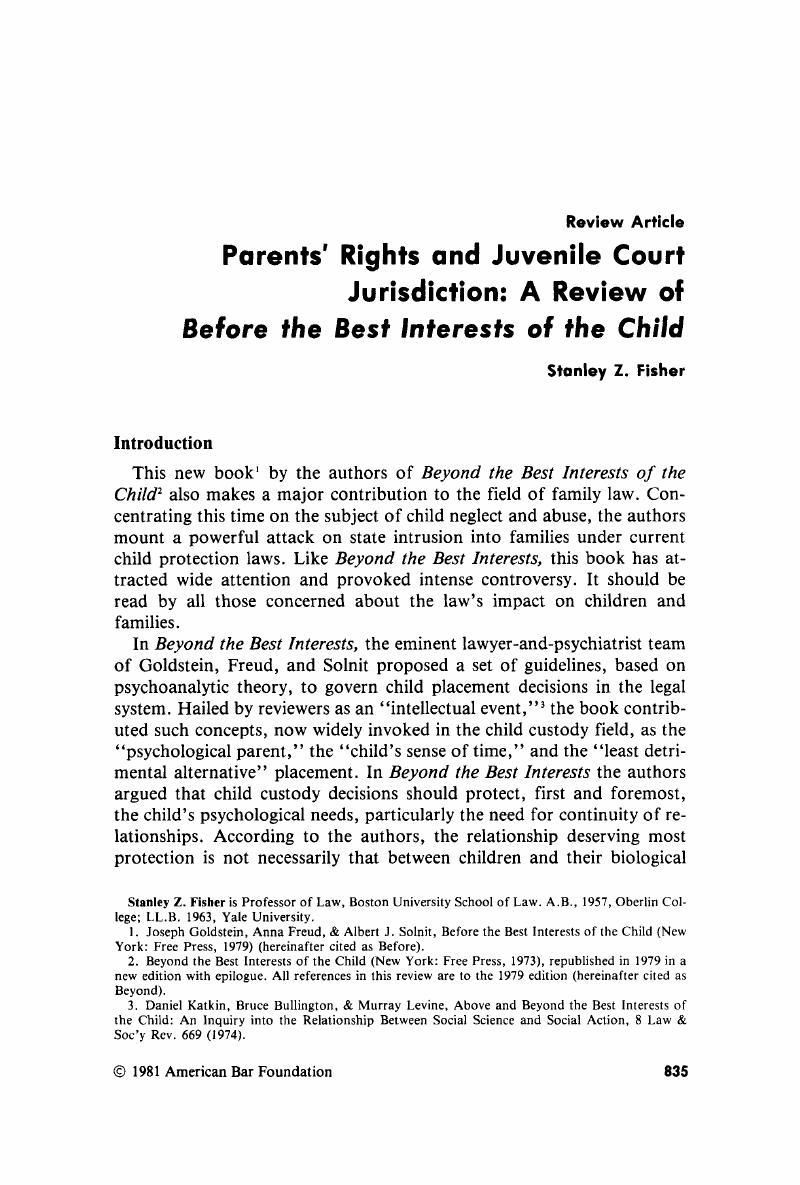Article contents
Parents' Rights and Juvenile Court Jurisdiction: A Review of Before the Best Interests of the Child
Published online by Cambridge University Press: 20 November 2018
Abstract

- Type
- Review Article
- Information
- Copyright
- Copyright © American Bar Foundation, 1981
References
1 Joseph Goldstein, Anna Freud, & Albert J. Solnit, Before the Best Interests of the Child (New York: Free Press, 1979) (hereinafter cited as Before).Google Scholar
2 Beyond the Best Interests of the Child (New York: Free Press, 1973), republished in 1979 in a new edition with epilogue. All references in this review are to the 1979 edition (hereinafter cited as Beyond).Google Scholar
3 Katkin, Daniel, Bullington, Bruce, & Levine, Murray, Above and Beyond the Best Interests of the Child: An Inquiry into the Relationship Between Social Science and Social Action, 8 Law & Soc'y Rev. 669 (1974).Google Scholar
4 For a survey of the review literature see Richard Edelin Crouch, An Essay on the Critical and Judicial Reception of Beyond the Best Interests of the Child, 13 Fam. L.Q. 49 (1979).Google Scholar
5 Beyond, supra note 2, at 115.Google Scholar
6 Strauss, Peter L. & Strauss, Joanna B., Book Review, 74 Colum. L. Rev. 996, 997 (1974).Google Scholar
7 Beyond, supra note 2, at 5.Google Scholar
8 Quoting from Beyond, supra note 2, at 105.Google Scholar
9 387 U.S. 1 (1967).Google Scholar
10 Pub. L. No. 93–247, 42 U.S.C. § 5101 et seq. (1976 & Supp. III 1979). The regulations are at 45 C.F.R. pt. 1340 (1980).Google Scholar
11 Institute of Judicial Administration-American Bar Association, Juvenile Justice Standards Project: Standards Relating to Abuse and Neglect (Cambridge, Mass.: Ballinger Publishing Co., Tent. Draft 1977). While 21 other volumes of draft Juvenile Justice Standards have been submitted to the ABA for approval, the Abuse and Neglect volume was not. It is currently being redrafted, IJA-ABA Juvenile Justice Standards Update, 13 Clearinghouse Rev. 667 (1980).Google Scholar
12 Wald, Michael S., Thinking About Public Policy Toward Abuse and Neglect of Children: A Review of Before the Best Interests of the Child, 78 Mich. L. Rev. 645 (1980).Google Scholar
13 These include the child's commission of criminal acts, and the parents' refusal to comply with generally applicable immunization, education, and labor laws so far as they apply to their children.Google Scholar
14 In their first book the authors rejected the feasibility of objectively defining the point at which a temporary caretaker becomes a “common law adoptive parent,” because “[t]he process through which a new child-parent status emerges is too complex and subject to too many individual variations for the law to provide a rigid statutory timetable.” Beyond, supra note 2, at 48. The definition of “longtime caretaker” in Before represents a significant change.Google Scholar
15 Long-time caretakers who do not wish to adopt the child would be designated the child's foster parents “with tenure.” That status would permit the foster parents to prevent intrusion by former parents or the state. Before, supra note 1, at 49.Google Scholar
16 IJA-ABA, supra note 11, pt. VII.Google Scholar
17 Id. pt. X. See also Adoption Assistance and Child Welfare Act of 1980, Pub. L. No. 96–272, 94 Stat. 500 (codified in scattered sections of 42 U.S.C.), § 475.Google Scholar
18 Even strong defenders of parental prerogatives appear to accept that view. See generally Hafen, Bruce C., Children's Liberation and the New Egalitarianism: Some Reservations About Abandoning Youth to Their “Rights,” 1976 Brigham Young U.L. Rev. 605.Google Scholar
19 Indeed, it seems the authors would permit parents to waive their child's right to trial, simply by asking the court to make a disposition based on a charge of delinquency. See authors' proposed Child Placement Code, 1 20.1(c), in Before, supra note 1, at 192.Google Scholar
20 431 U.S. 678 (1977) (striking down New York's prohibition on sale or distribution of contraceptives to minors).Google Scholar
21 443 U.S. 622 (1979) (state law may not condition minor's abortion on parent's consent; if court finds minor is mature and fully informed, court may not deny minor permission for abortion). See also H.L. v. Matheson, 3 Fam. L. Rep. 3021 (Mar. 24, 1981) (upholding statute requiring notice of abortion to parents, as applied to unemancipated dependent minor who claimed neither that she was mature nor that parental notice would conflict with her best interests).Google Scholar
22 442 U.S. 584 (1979) (applying only minimal due process protections to parent's “voluntary” commitment of child to mental hospital).Google Scholar
23 442 U.S. 707 (1979) (upholding 16-year-old murder suspect's waiver of Miranda rights, despite police refusal to honor suspect's request for presence of probation officer). See also Lassiter v. Dep's of Social Servs., 49 L.W. 4586 (June 2, 1981) (indigent parent has no automatic due process right to counsel in proceeding to terminate her parental rights).Google Scholar
24 Beyond, supra note 2, at 11.Google Scholar
25 While it would be hard to say whether the parent or the child risks more in a neglect proceeding, it seems clear in delinquency proceedings that the child has the most to fear. In part that is because delinquents typically are adolescents, whose bond with their parents is already somewhat loosened.Google Scholar
26 Institute of Judicial Administration-American Bar Association, Juvenile Justice Standards Project: Standards Relating to Pretrial Court Proceedings pt. IV (Cambridge, Mass.: Ballinger Publishing Co., 1980).Google Scholar
27 Breed v. Jones, 421 U.S. 519, 528, 529 (1975).Google Scholar
28 See Burt, Robert A., The Constitution of the Family, 1979 Sup. Ct. Rev. 329.Google Scholar
29 Philip E. Slater, Social Change and the Democratic Family, in Warren G. Bennis & Philip E. Slater, The Temporary Society 20, 37 (New York: Harper & Row, 1968).Google Scholar
30 Id. at 37 ff.Google Scholar
- 2
- Cited by




